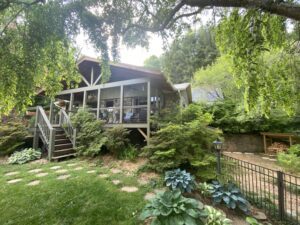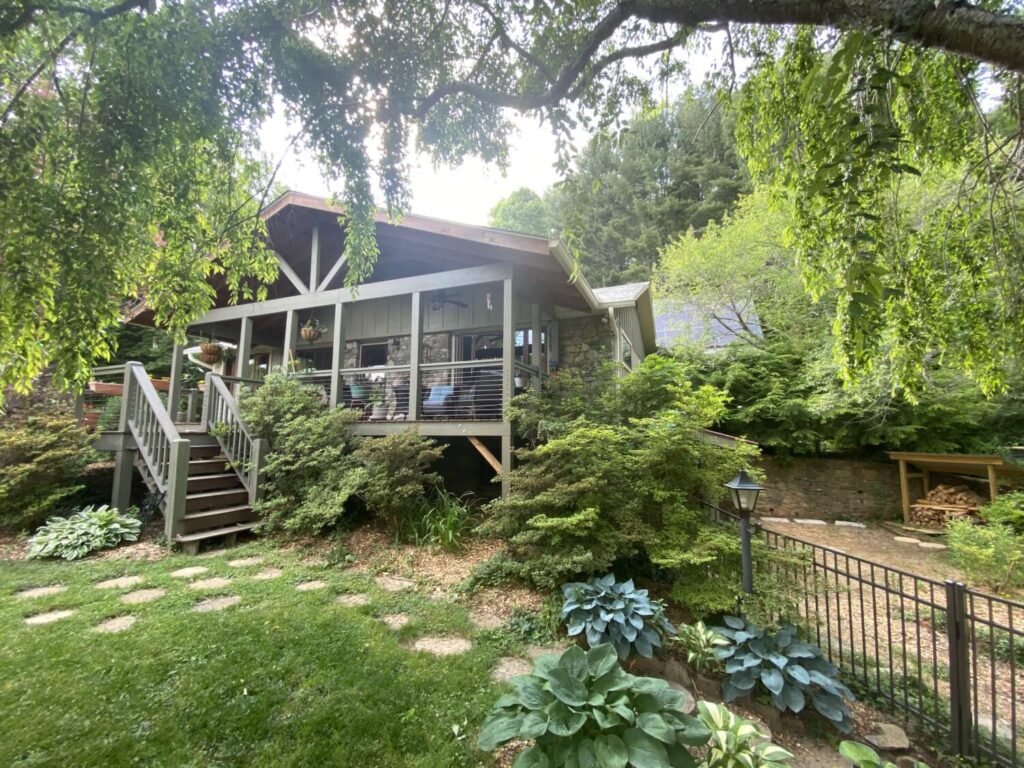
It has always appealed to me to live in a home that uses fewer resources than average.
My first home was a salvaged 1800s log cabin rescued from the kudzu in the woods above Durham, N.C. It was fitted with four solar panels, six deep-cell batteries, solar hot water, a composting toilet, a gas refrigerator and cook stove, and a wood stove for heat.
Thanks to the tax incentives available at the time, I was able to enter the world of alternative energy for just a few thousand dollars. Using simple solar tools, we managed our daily energy use with the forecasted sun. On the evenings of the days when I had driven to my part-time job 25 miles away, I would plug my house into our small truck to supplement our energy, rinsing and wringing out the laundry after it had rolled around in the sudsy tub in the bed of the truck and hanging it to dry on the line out back.
It was 28 years later in an Asheville subdivision where my husband and I found our dream home site with a 1977 ranch house sitting squarely in the middle. Close to town and our work, with lots of sun, we had faith we could transform this version of the standard American home into a low-energy, high-performance homestead for our family.
The house needed remodeling to meet our needs so we made our plans and then took it down to the studs, moving walls to accommodate a larger kitchen and master bedroom and bath, and converting a bedroom to our shared office.
The first step was to address the building envelope. As students of sustainability, we had learned that as much as 40 percent of a home’s heating and cooling loads can be reduced by improving the walls, windows and insulative values of the home. Our choice of a higher efficiency fiberglass window increased our overall envelope performance while also allowing us to open the interior to more light and views.
After moving walls around, we removed the paneling to replace it with sheetrock. In the process, we realized that the original fiberglass insulation was not filling the wall cavities completely, gapping at the top and bottom, and not offering a complete insulative barrier. We decided to replace all the old fiberglass insulation in the walls and ceiling (offering it to another home remodeler for reuse) with a whole-home foam insulation system.
Over time, we discovered that a spray-foam system could contribute to increased moisture in attic spaces and so we made the decision to install a dehumidifier in the attic as a preventative measure.
The appliances we purchased were ENERGY STAR® certified and have proved to be good stewards of our electrical usage.
Solar and Electric
Our new home was perfectly situated with a large south-facing roof over the two-story garage that served as the perfect site for new solar panels. In 2012, we installed 27 solar panels, initially leaving enough roof space for a solar hot water system. Through an energy evaluation, we were advised that more photovoltaic (PV) panels and a heat pump water heater would be a better option for us.
In 2019, we added six new PV panels to that roof space and supplemented the whole system with two batteries to provide us with backup security in case of power outages. Our home is at the end of an electrical distribution line and we were often the last folks to be serviced if the power goes out.
A solar monitoring system ties it all together and allows us to watch how the system performs, as well as to know when the power is off because frankly we hardly notice when it is. A secondary electric panel, dedicated to the primary circuits that we want supported by the batteries, offers us a core stability when the main grid is down.
On average, we export more energy to the grid than we use. The bulk of our usage comes from the nighttime hours when we charge our electric car. We are now researching smart-home energy monitors to help us see in real time where our main usage is so we can make informed decisions on any future upgrades.
That same solar orientation baked the front rooms of our home in the summer and made the front porch virtually impossible to enjoy. We designed a vaulted ceiling porch to be built across the front, shading our living room and office during the hot summer days without blocking the light in the winter.
We used sustainably harvested ipe wood for the deck, ceiling fans to help move the air, and added a secondary, unroofed deck for night star gazing and great plant growing. Overlooking our front gardens, this restful space has become a favorite spot for us to entertain, work and relax, rain or shine.
When the aging HVAC system needed replacement, we chose a geothermal heating system as a replacement. By leveraging geothermal energy, we benefit from a base exchange temperature much closer to the desired indoor temperature than can be achieved with a traditional heat exchange system that uses outdoor air. This system utilized the existing ducts in our home, adding two 250-foot deep wells to provide the approximate 59-degree temperature that is common in the ground around Asheville.
For redundancy, we installed a woodstove in the downstairs utility room located right below the main living space as an alternate heat source should the need arise. A vented propane log set in the living room fireplace warms us in the brief times we need it, allowing us to keep our overall home temperature low.
In 2015, we leased our first electric vehicle. Now in our sixth year of EV ownership, we are happy to be able to direct the energy from our batteries to charge our car at night if need be, allowing us to drive on sunshine.
While pursuing a certificate in Climate and Society in connection with my master’s degree at University of North Carolina Asheville, I took the opportunity to study the value and success of our home-renovation efforts on our overall greenhouse-gas impacts. Ironically, we noticed some of our largest energy reductions by switching all our old incandescent and compact fluorescent bulbs to LEDs. One of my favorite finds has been LED battery bulbs that charge in our lamps during regular usage and provide us with another source of backup lighting during power outages.
Outdoor Spaces
In 2020, we installed a 3,000-gallon rainwater collection system both to balance the flow of water on our property and to support the irrigation of our gardens. It is such a delight to be able to water our gardens with the rainwater we have collected. Rain gauges in the garden help us understand how much water we have collected and need to use. Our system fills up with just two inches of rain and allows us to direct the saved water throughout the garden with a soaker hose network to reduce waste.
We are currently designing a greenhouse for the southwest side of our home that will capture the sunlight and heat during winter and allow me to grow more vegetables year round. I am hopeful that I can retire the LED fluorescent grow lights once this project is finished and further reduce our overall annual footprint.
Our love of gardening has led us to reduce the lawn to a third of the size it was when we purchased the property, adding perennials, vegetables and small fruits to the well-mulched beds that ring the slowly disappearing grass. These beds are home to millions of earthworms and help us recognize the success of our soil-building activities.
Our chicken coop is a working compost bin, transforming the weeds, household and garden trimmings, and community-salvaged leaves into rich, healthy soil.
The addition of a new electric lawn mower has not only reduced the noise impact of the mowing chore, but cut the carbon footprint completely. We now mow with solar energy.
It has been a satisfying exercise for our family to work on this home. We have become more aware of the small things we can do to reduce our impact on the planet and welcomed the opportunity to invest in our home as a means of investing in the future.
We were fortunate to have utilized available tax incentives to save a lot on the overall costs of our systems for solar, insulation, the electric vehicle and the geothermal HVAC. But even without those incentives, the value of these installations has been proven to us over time.
Not everyone can afford a new green home, but we can all take the homes we have and improve their performance. We have learned with this old house that even the standard American ranch house can be converted to a high efficiency home.
Robin Cape invests in a brighter future for her grandchildren by committing to use green technologies in her own life. Robin is a broker with the Bold Mountain Team at Nest Realty and chair of Green Built Alliance’s Board of Directors. Connect with Robin at boldmountainteam.com.
You can also view this article as it was originally published on page 36 of the 2021-22 edition of the directory.


